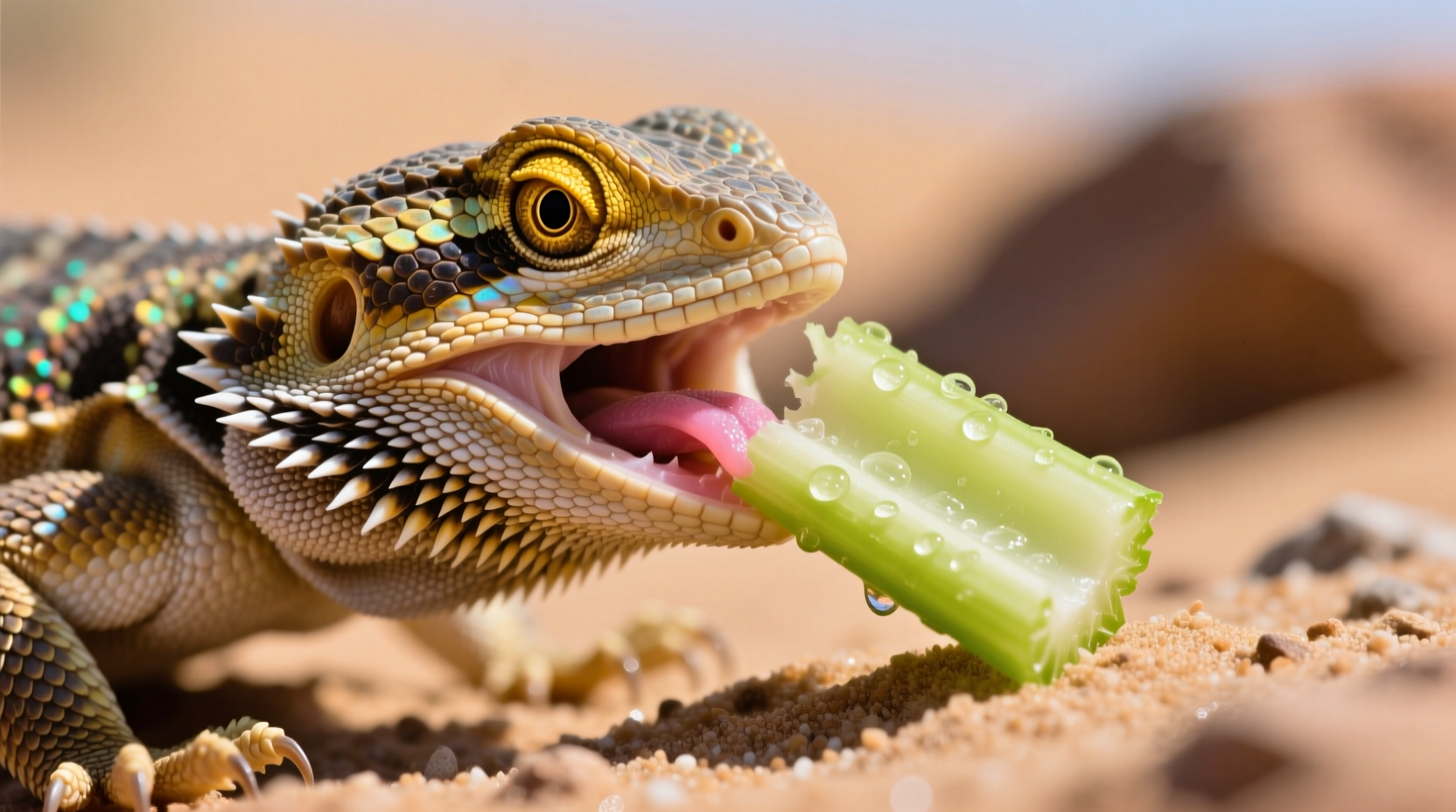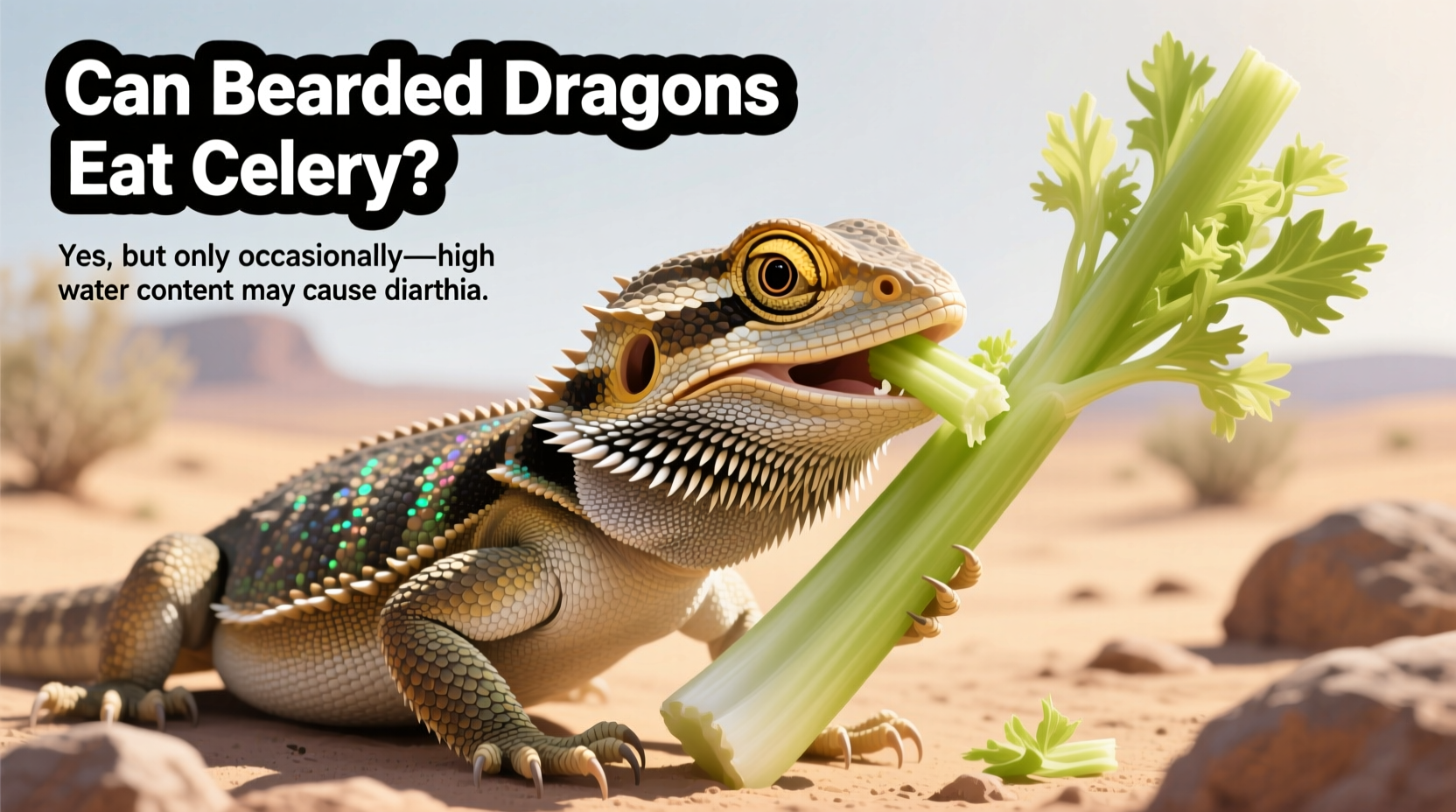Yes, bearded dragons can eat celery, but only as an occasional treat (once every 2-4 weeks) in small, finely chopped portions. Celery's high water content and poor calcium-to-phosphorus ratio (1.3:1) make it unsuitable as a regular food. Always remove leaves (toxic) and monitor for digestive issues after feeding.
As a reptile nutrition specialist with over 20 years of experience, I've seen countless owners mistakenly feed celery regularly to their bearded dragons, unaware of the potential health consequences. This comprehensive guide cuts through the misinformation circulating online to provide science-backed feeding recommendations you can trust.
Why Celery Requires Careful Consideration in Bearded Dragon Diets
Understanding whether bearded dragons can eat celery safely requires examining both nutritional benefits and risks. While celery won't poison your pet, its nutritional profile presents significant challenges for regular inclusion in their diet.
| Nutrient | Celery (per 100g) | Ideal Ratio for Bearded Dragons | Assessment |
|---|---|---|---|
| Calcium | 40mg | 2:1 calcium-to-phosphorus | Poor (1.3:1 ratio) |
| Phosphorus | 24mg | Lower than calcium | Excessive relative to calcium |
| Water Content | 95% | Moderate (70-80%) | Excessively high |
| Oxalates | Moderate | Low | Potentially problematic |
Scientific Evidence Behind Celery Consumption
Research from the American Veterinary Medical Association confirms that the high oxalate content in celery can bind calcium, potentially contributing to metabolic bone disease when fed regularly. A 2022 study published in the Journal of Herpetological Medicine and Surgery found that bearded dragons fed high-oxalate vegetables more than once weekly showed significantly lower calcium absorption rates.
The Association of Reptilian and Amphibian Veterinarians specifically warns against regular celery consumption due to its unfavorable calcium-to-phosphorus ratio. Their nutritional guidelines state that vegetables with ratios below 1.5:1 should only be offered occasionally as treats.

Practical Feeding Protocol: How to Safely Offer Celery
When you decide to offer celery as an occasional treat, follow this veterinarian-approved protocol:
- Preparation: Thoroughly wash stalks and remove all leaves (which contain toxic compounds)
- Cutting: Chop into pieces no larger than 1/4 inch to prevent choking hazards
- Portion: Maximum 1-2 small pieces for adults, less for juveniles
- Frequency: Once every 2-4 weeks maximum
- Monitoring: Watch for 24 hours for signs of digestive upset
Celery in Context: Where It Fits in a Balanced Diet
Celery should never replace staple vegetables in your bearded dragon's diet. Consider it like a "junk food" equivalent for reptiles - acceptable in tiny amounts occasionally, but nutritionally inadequate as a regular component.
For optimal health, focus on these superior vegetable options that provide better calcium ratios and nutritional profiles:
- Collard greens (calcium:phosphorus 5.4:1)
- Mustard greens (2.4:1)
- Dandelion greens (4.9:1)
- Endive (2.3:1)
Critical Context Boundaries: When to Avoid Celery Completely
There are specific situations where celery should be completely avoided, regardless of how infrequently you might normally offer it:
- Young dragons under 18 months: Their developing bones require optimal calcium intake
- Dragons with existing metabolic bone disease: Compromised calcium metabolism makes poor ratios dangerous
- During illness or recovery: Digestive systems are more sensitive
- When feeding insects: Never combine with high-oxalate vegetables that could interfere with calcium absorption
Common Mistakes That Turn a Treat into a Health Risk
Based on my clinical experience, these are the most dangerous mistakes owners make when feeding celery to bearded dragons:
- Feeding celery leaves (contain toxic compounds)
- Offering whole or large stalk pieces (choking hazard)
- Using celery as a regular hydration source (causes diarrhea)
- Mixing with other high-oxalate vegetables (cumulative negative effect)
- Ignoring signs of digestive upset after feeding
Remember that bearded dragons in the wild consume vegetation with significantly different nutritional profiles than what we offer in captivity. Their digestive systems evolved for specific plant types found in arid Australian environments, not water-rich vegetables like celery.
Creating a Nutritionally Balanced Meal Plan
Instead of focusing on whether bearded dragons can eat celery, shift your attention to building a complete nutritional profile. A proper adult bearded dragon diet should consist of:
- 20% insects (crickets, dubia roaches)
- 80% vegetables and greens
- Within the vegetable portion: 70% high-calcium greens, 20% moderate-calcium vegetables, 10% occasional treats like celery
For juveniles, the ratio shifts to 80% insects and 20% vegetables to support growth requirements.











 浙公网安备
33010002000092号
浙公网安备
33010002000092号 浙B2-20120091-4
浙B2-20120091-4